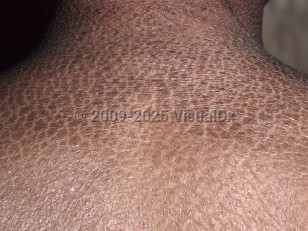Ichthyosis vulgaris in Child
Alerts and Notices
Important News & Links
Synopsis

Ichthyosis vulgaris (IV) is a common inherited skin condition characterized by xerosis and scaling. The term ichthyosis is derived from the Greek word for "fish" and describes the fish-like scaly appearance of the skin in this family of disorders.
IV affects approximately 1 in 250-1000 individuals worldwide and is inherited in an autosomal dominant fashion with variable penetrance and expressivity ranging from mild scaling in heterozygotes to severely impaired skin barrier function in homozygotes. There is no known ethnic or sex predilection. There is a strong seasonal and environmental variation in disease severity. The disease is more severe in winter and is exacerbated by low humidity and alkaline skin care products such as soaps and detergents. Hydration, lubrication, and keratolysis are the mainstays of therapy.
IV is primarily caused by loss-of-function mutations in the filaggrin (FLG) gene. Filaggrin is responsible for keratin aggregation during the terminal differentiation of keratinocytes. Altered filaggrin expression results in abnormal cornification of the skin with poor barrier function and increased transepidermal water loss.
The condition typically presents in early childhood and follows a favorable course in which the scaling diminishes in severity by adulthood. Xerotic skin with flaky scales typically develops on the abdomen and extensor surfaces of the extremities with sparing of the flexural surfaces. Hyperkeratosis of the palms and soles accentuate the normal skin creases and in severe cases, can result in painful fissures.
The loss of skin barrier function in IV is associated with an atopic diathesis with over 50% of patients affected by early-onset atopic dermatitis. Keratosis pilaris may be associated.
IV affects approximately 1 in 250-1000 individuals worldwide and is inherited in an autosomal dominant fashion with variable penetrance and expressivity ranging from mild scaling in heterozygotes to severely impaired skin barrier function in homozygotes. There is no known ethnic or sex predilection. There is a strong seasonal and environmental variation in disease severity. The disease is more severe in winter and is exacerbated by low humidity and alkaline skin care products such as soaps and detergents. Hydration, lubrication, and keratolysis are the mainstays of therapy.
IV is primarily caused by loss-of-function mutations in the filaggrin (FLG) gene. Filaggrin is responsible for keratin aggregation during the terminal differentiation of keratinocytes. Altered filaggrin expression results in abnormal cornification of the skin with poor barrier function and increased transepidermal water loss.
The condition typically presents in early childhood and follows a favorable course in which the scaling diminishes in severity by adulthood. Xerotic skin with flaky scales typically develops on the abdomen and extensor surfaces of the extremities with sparing of the flexural surfaces. Hyperkeratosis of the palms and soles accentuate the normal skin creases and in severe cases, can result in painful fissures.
The loss of skin barrier function in IV is associated with an atopic diathesis with over 50% of patients affected by early-onset atopic dermatitis. Keratosis pilaris may be associated.
Codes
ICD10CM:
Q80.0 – Ichthyosis vulgaris
SNOMEDCT:
254157005 – Ichthyosis vulgaris
Q80.0 – Ichthyosis vulgaris
SNOMEDCT:
254157005 – Ichthyosis vulgaris
Look For
Subscription Required
Diagnostic Pearls
Subscription Required
Differential Diagnosis & Pitfalls

To perform a comparison, select diagnoses from the classic differential
Subscription Required
Best Tests
Subscription Required
Management Pearls
Subscription Required
Therapy
Subscription Required
References
Subscription Required
Last Reviewed:06/18/2019
Last Updated:01/17/2022
Last Updated:01/17/2022
 Patient Information for Ichthyosis vulgaris in Child
Patient Information for Ichthyosis vulgaris in Child
Premium Feature
VisualDx Patient Handouts
Available in the Elite package
- Improve treatment compliance
- Reduce after-hours questions
- Increase patient engagement and satisfaction
- Written in clear, easy-to-understand language. No confusing jargon.
- Available in English and Spanish
- Print out or email directly to your patient
Upgrade Today

Ichthyosis vulgaris in Child

